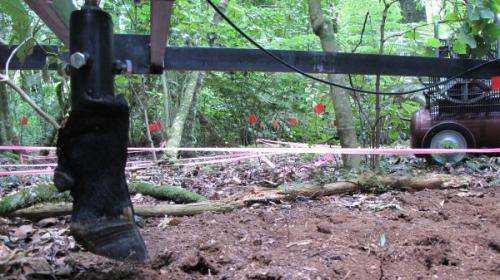Mechanical hoof tests effect of livestock on native snail populations

Even low frequency trampling by livestock can reduce the density and biodiversity of forest snails, according to experimental evidence collected using a mechanical cow hoof.
A team led by recent UWA Masters graduate Lisa Denmead devised and constructed the pneumatic cow's hoof, using it to simulate different trampling frequencies and measure the effect on native land snail populations in remnant forest in New Zealand.
"New Zealand has one of the most species-rich snail faunas in the world; also, importantly for research, they are known as a group that is sensitive to environmental disturbance," Ms Denmead says.
"We found even a very small amount of livestock trampling in native forests can have a large negative effect on snails."
When Ms Denmead used the mechanical hoof to simulate even the lowest frequency trampling—equivalent to a herd of 45 adult Friesian cows traversing a standard-sized remnant twice in six weeks—the number of snails per square metre dropped by an average of
42, and biodiversity declined by 10 snail species per plot.
Higher intensity trampling—equivalent to weekly trampling by the same herd over six weeks—reduced snail numbers by 100 snails per square metre, cutting biodiversity from 91 species down to 78 species.
Innovative hoof for standardised experiment
Ms Denmead constructed the mechanical hoof, which comprised a compressor-powered pneumatic ram attached to a real cow hoof, sourced from an abattoir, to ensure random but highly repeatable trampling.
"If we'd used a real cow it would have been hard to standardise the experiment, so we came up with the idea to use a mechanical hoof…it was built at my uncle's engineering workshop."
Since the reduction in snail numbers was not accompanied by increased soil compaction or reduced leaf litter moisture (factors normally linked to lower snail populations), Ms Denmead suggests the snails were quite simply crushed.
"Although some farmers value native forest remnants on their farms for shelter for livestock, even a minimal amount of access can have major impacts and should be discouraged," she says.
Ms Denmead recorded average snail densities of 170 snails per square metre, but says snail densities in New Zealand can reach up to 6000 snails per square metre.
"The highest densities of snails are likely to be found in large forest reserves with little disturbance.
"Although our remnant had been fenced for more than 20 years, it is still a relatively small remnant, and on farmland which would've likely had some disturbance over time."
More information: Denmead, L. H., Barker, G. M., Standish, R. J., Didham, R. K. (2015), "Experimental evidence that even minor livestock trampling has severe effects on land snail communities in forest remnants." Journal of Applied Ecology, 52: 161–170. doi: 10.1111/1365-2664.12370
Journal information: Journal of Applied Ecology
Provided by Science Network WA





















